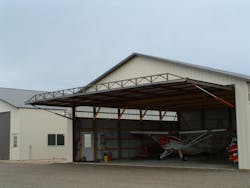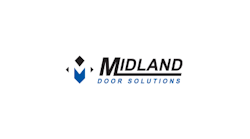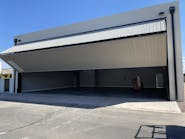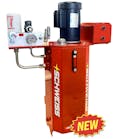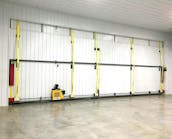Open Doors Top 4 Safety Features to Look For On Hangar Doors
Putting safety first opens many doors — especially when making decisions on purchasing large hangar doors for aircraft hangars. Key safety features save owners on costly replacements, as well as prevent potential injuries.
Consider these four safety features when shopping for your next door:
1. Safety Sensors
It’s important for a door to recognize if an obstruction is in the way as it closes. Choose a door with photo eyes or safety-sensing edges. Photo eyes transmit a beam a few inches off the floor; if something breaks the beam, the door automatically stops and reverses. Safety sensing edges attach to the bottom of the doorframe and cause the door to stop and reverse if something makes contact with them.
While photo eyes and safety-sensing edges aren’t new technology, not all doors feature these. The alternative is a door wired to operate only with constant pressure on the push button during the close cycle. This is required for any door without photo eyes or safety-sensing edges, but when the operator removes his finger from the push button the door will stop.
2. Safety Switches
Unless a door has an automatic latch, a single latch handle needs to be manually released prior to opening the door. Look for a single latch handle that incorporates a safety switch to prevent the door from starting until it’s unlocked. This will save on expenses associated with damage from trying to open the door while it’s locked in place.
Some manufacturers also offer optional top override switches. These serve as backup safety switches if the limit switch in the control box fails. When contact is made with the override switch, it stops the door from traveling past its opening height.
3. Safety in Strength
For long-term durability, select a door made of all-steel construction rather than a combination of wood and steel. Also confirm that the door’s construction meets the current wind load requirements of the building code. Some older doors may lack strength because they were built according to older building codes based off of lower wind loads.
4. Safety Rating
Last but certainly not least, check to see if the manufacturer has a high safety rating. For example, a door with a 5 to 1 safety rating means the cables and straps opening the door can withstand stress that is five times greater than the weight of the door.
With these tips in mind, you’ll be well on your way to finding a door that puts safety first.
Jason Myrvik is the general manager at Midland Door Solutions, which manufactures and installs bi-fold and hydraulic doors for new and existing buildings. He has more than 16 years of industry experience. As general manager, he oversees the manufacturing and installation departments, ensuring the best customer service from the door design to production to on-site installation. Contact him at [email protected].
